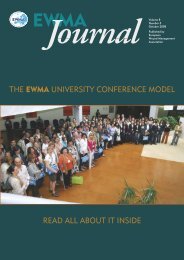best practice for the management of lymphoedema ... - EWMA
best practice for the management of lymphoedema ... - EWMA
best practice for the management of lymphoedema ... - EWMA
Create successful ePaper yourself
Turn your PDF publications into a flip-book with our unique Google optimized e-Paper software.
Intermittent pneumatic<br />
compression<br />
Although <strong>the</strong>re is considerable<br />
international debate over its effectiveness<br />
in <strong>lymphoedema</strong>, intermittent pneumatic<br />
compression (IPC) is widely used. It may<br />
<strong>for</strong>m part <strong>of</strong> an intensive <strong>the</strong>rapy regimen<br />
or long-term <strong>management</strong> in selected<br />
patients, and may be used with caution in<br />
<strong>the</strong> palliative situation.<br />
WHAT IS IPC?<br />
IPC consists <strong>of</strong> an electrical air compression<br />
pump attached to an inflatable plastic<br />
garment that is placed over <strong>the</strong> affected<br />
limb. The garment is inflated and deflated<br />
cyclically <strong>for</strong> a set period, usually about<br />
30-120 minutes. The pressure produced by<br />
<strong>the</strong> garment can be varied. Garments may<br />
be single chambered, or contain multiple<br />
chambers (usually three, five or 10) that are<br />
inflated sequentially to provide a peristaltic<br />
massaging effect along <strong>the</strong> length <strong>of</strong> <strong>the</strong><br />
limb towards its root.<br />
The question <strong>of</strong> whe<strong>the</strong>r single or<br />
multichambered devices are more effective<br />
remains open. However, multichambered<br />
devices are used most frequently and<br />
randomised controlled trials have shown<br />
<strong>the</strong>m to produce a faster effect 64,65 .<br />
IPC is thought to reduce oedema by<br />
decreasing capillary filtration, and <strong>the</strong>re<strong>for</strong>e<br />
lymph <strong>for</strong>mation, ra<strong>the</strong>r than by<br />
accelerating lymph return.<br />
IPC is particularly effective in<br />
nonobstructive oedemas, eg those due to<br />
immobility, venous incompetence,<br />
lymphovenous stasis or hypoproteinaemia.<br />
In obstructive <strong>lymphoedema</strong>, ie<br />
<strong>lymphoedema</strong> resulting from lymphatic<br />
vessel/node damage or lymph node<br />
resection, SLD or MLD is recommended<br />
be<strong>for</strong>e IPC to stimulate lymphatic flow 66 .<br />
It is important that compression <strong>the</strong>rapy<br />
with garments or bandaging is continued<br />
after IPC to prevent rapid rebound swelling.<br />
Contraindications to IPC are listed in Box 21.<br />
BOX 21 Contraindications to IPC<br />
■ Untreated nonpitting chronic <strong>lymphoedema</strong><br />
■ Known or suspected deep vein thrombosis<br />
■ Pulmonary embolism<br />
■ Thrombophlebitis<br />
■ Acute inflammation <strong>of</strong> <strong>the</strong> skin, eg cellulitis/erysipelas<br />
■ Uncontrolled/severe cardiac failure<br />
■ Pulmonary oedema<br />
■ Ischaemic vascular disease<br />
■ Active metastatic disease affecting oedematous region<br />
■ Oedema at <strong>the</strong> root <strong>of</strong> <strong>the</strong> affected limb or truncal oedema<br />
■ Severe peripheral neuropathy<br />
Caution required: peripheral neuropathy, pain or numbness in <strong>the</strong> limb, undiagnosed, untreated or<br />
infected wounds, fragile skin, grafts, skin conditions that may be aggravated by IPC, extreme limb<br />
de<strong>for</strong>mity (may impede correct use <strong>of</strong> IPC).<br />
GUIDELINES FOR USE<br />
Consensus on <strong>the</strong> pressures suitable <strong>for</strong><br />
IPC in <strong>lymphoedema</strong> is lacking.<br />
Careful surveillance is required to ensure<br />
that <strong>the</strong> correct technique and pressures<br />
are applied. Pressures should be adjusted<br />
according to patient tolerance and<br />
response to treatment. In general:<br />
■ pressures <strong>of</strong> 30-60mmHg are advised<br />
■ lower pressures are advised in palliative<br />
care, eg 20-30mmHg<br />
■ a duration and frequency <strong>of</strong> 30 minutes<br />
to two hours daily is recommended 66-68 .<br />
IPC may exacerbate or cause congestion or<br />
a ring <strong>of</strong> fibrosis at <strong>the</strong> noncompressed root<br />
<strong>of</strong> a treated limb if <strong>the</strong> lymphatics in <strong>the</strong><br />
root <strong>of</strong> <strong>the</strong> limb have not been cleared. IPC<br />
<strong>of</strong> <strong>the</strong> lower limbs may precipitate genital<br />
oedema 69 .<br />
IPC is not recommended if <strong>the</strong>re is<br />
oedema at <strong>the</strong> root <strong>of</strong> <strong>the</strong> limb or in <strong>the</strong><br />
adjacent trunk.<br />
IPC should be prescribed and per<strong>for</strong>med<br />
by practitioners who have received<br />
appropriate training at specialist level.<br />
BEST PRACTICE FOR THE MANAGEMENT OF LYMPHOEDEMA 31<br />
IPC

















